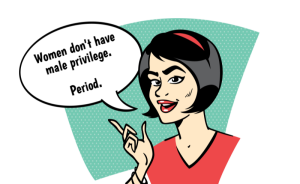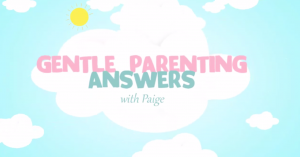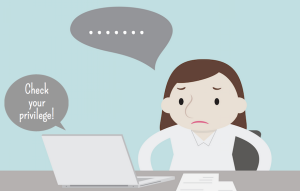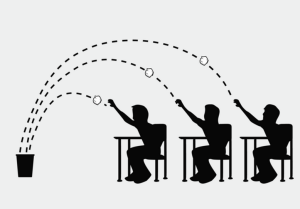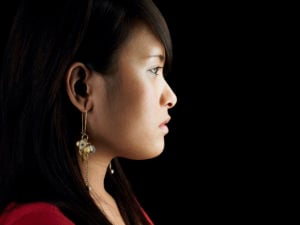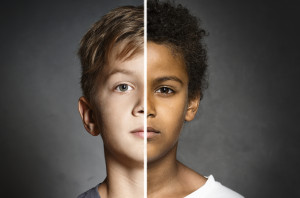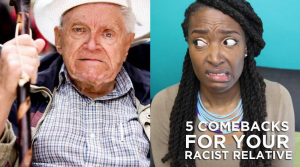“Beware of those who compliment us on how clean, hard-working, and self-reliant we are. Beware of those who tempt us with compliments about our old and venerable culture.” —Elaine Kim
So here’s one of my secret-not-so-secret confessions: I am, have always been, and always will be a “bad” example of an Asian.
I’m lazy, bossy, extremely left-wing, and I consistently fail at anything related to math, science, or technology.
I never listen to my parents; I smoke cigarettes out of my bedroom window when I go home for the holidays; and I don’t really speak any Asian language aside from what’s necessary to order food that’s not on the menu for white people at Chinese restaurants. (Oops, sorry to bust your bubble about that one, white folks).
When I was a kid, I absolutely despised anything remotely “Chinese” that my parents gave me for lunch. Iwould throw the sticky rice my grandmother made and painstakingly stuffed with pork, pickled egg, and boiled peanuts, into the trash.
I would then offer to do other kids’ math homework for them in exchange for some of their lunch money. They always took me up on it because they thought that since I was Asian, I had to be good at math (see above).
This is what happens when you grow up Asian in a white supremacist society: It makes you despise your family. It makes you despise yourself, for being different.
At night I would lie awake in my bed and dream about running away, leaving the neighborhood, changing my gender, getting tattoos, going to parties, having sex, becoming a writer. I would dream of being bad, of being beautiful. I would dream of being myself – if I could only figure out who and what that was.
My parents loved and embraced the model minority myth: Like many East and South Asian migrants of their generation, this was the only way that they had survived in a society that simultaneously hated and exploited them.
My mother and father took the racist notions that Asians were hard-working, school-smart, and rule-abiding (read: non-threatening to white people), and proved them beyond a shadow of a doubt.
My parents became the first in their families to get university degrees. My mother followed this up by getting into med school – no small feat for a working-class Asian woman in the 80s – while my father worked three jobs to support us. For as long as I remember, my parents never went out, never took holidays, never bought themselves new clothes unless absolutely necessary.
They didn’t do this because they wanted to, or because it came naturally to them. They did it so their children could have better lives. They did it because they believed had no choice.
What all this meant for me was that growing up, I had no access to role models of Asians who were bold and rebellious, no Asian James Dean or Lara Croft.
As I got older and started participating in racial justice activism, I became increasingly conscious of the lack of Asian in representation North American social movements. Today, Indigenous and Black-led movements like Idle No More and Black Lives Matter are changing the way we talk and think about race, while many (though not all) North American Asian communities have remained conspicuously silent on the matter.
Where were the Asian revolutionaries? I wondered. The Asian punks? The Asian artists, writers, anti-establishment loudmouths?
Did I really come from, as writer Kurt Vonnegut once put it, a community of “yellowrobots fueled by rice?”
It took me a long time to discover the secret history of Asian revolution in North America, and even longer to find a community of Asians (of many ethnic, linguistic, and cultural backgrounds) who shared my desire – my need – to throw off superficially “positive” stereotypes so that we could find a racial identity that spoke more truly to who we were.
Together, over many nights of laughing and crying together, attending protests, painstakingly relearning forgotten childhood languages, and orchestrating daringly risqué photo shoots, we put together the pieces:
So-called positive stereotypes about Asians are only the latest part of a long history of erasing our experiences and humanity. While our communities may have been forced to embrace these stereotypes as a means of survival, they were never meant to help us or to change prejudicial attitudes about us among white society.
Instead, “positive” stereotypes are a backhanded way of justifying more discrimination against Asians and of silencing our voices. They are meant to incite competition between Asians and other People of Color, and to encourage us to assimilate into a racist social hierarchy instead of breaking it down.
The following list of affirmations goes out to all my fellow bad Asians, and to every Asian who has ever dreamed of being bad. It is, at the same time, a list of reasons why “positive” stereotypes about us need to be taken down.
Because we aren’t, have never been, and will never be the good little “yellow robots” that this racist society wants us to become.
1. Stereotypes About ‘Good’ Asians Have Always Been Used to Exploit Us
I grew up in Canada, a country that has always prided itself on being liberal and multicultural – or at least, more liberal and multicultural than our neighbor to the south. I was taught in school that Asians have always been a “welcomed addition” to Canadian society because of our hard work ethic.
I later found out what John A. MacDonald, our first Prime Minister (the Canadian equivalent of President) really thought about Chinese migrants: “While [the Chinese] gives us labour he is paid for it, and is valuable, the same as a threshing machine or any other agricultural implement.”
In other words, the only reason Asian migrants were let into the country was because we were “useful machines” to white folks – and, oh yeah, what MacDonald forgot to mention was that Asian workers were paid five cents to the white man’s dollar.
The situation in the United States was virtually the same, with Asian migrants being exploited as cooks, launderers, railroad workers, and other forms of cheap labor.
Things have changed somewhat, of course, today – but I still can’t help but notice that Asians in North America are still funneled into work that is “useful” and “mechanical,” and not often into the politics or leadership.
And even in fields where Asians supposedly excel, like science and tech, and where we comprise large percentage of the workforce, we are very rarely managers or executives.
I can’t help but wonder if when my white teachers told me that I should work hard in math and science like my fellow Asian classmates – but refused to give me grades in drama or display my art – they were really saying:
Become someone who is compliant and useful to us. Don’t make trouble. Become a pharmacist or a computer programming drone. Don’t take up space or question authority. You are most valuable as a machine.
2. ‘Good’ Stereotypes Are a Double-Edged Sword
According to the current cultural narrative about Asians, we’re doing really well at assimilating in mainstream (read: white) society and climbing up the social ladder.We’re supposedly doing better in school than anyone else, getting into university at higher rates than anyone else, and making more money than anyone else.
But if you look a little deeper, you’ll see that these stereotypes refer only to the successes of middle-class Chinese, Japanese, Korean, and Indian communities in the USA and Canada.
Mainstream media never seems to remember that only 12-13% of Hmong, Laotian, and Cambodian Americans have a college degree, and less than 10% of Samoan Americans do.
Asian Americans are also more likely to suffer from long-term unemployment, which is something you don’t hear about very often (gee, I wonder why).
And even those Asian communities that are doing well socioeconomically should beware of the backlash that comes from playing the game of assimilation too well: College quotas are being raised to keep Asian enrollment relatively low, much in the same way that unofficial caps were once placed on Jewish university enrollment to keep them from being “overrun.”
Whenever I read an article about how well Asians are doing in the workforce compared to everyone else, or how universities are becoming “too Asian,” I hear a slight note of hysteria behind the words and the apparently complimentary stereotypes – a hint of fear that Asians are beating white folks at their own game.
I wonder how long it will be before this hint of fear explodes into a full-on anti-Asian panic, wherein our communities will be accused of stealing jobs and college seats from “real” white North Americans – a panic similar to the fear of Yellow Peril that once resulted in Chinatowns across the world being burnt to the ground.
3. Being ‘Good’ Asians Means Being Pitted Against Other People of Color
“when i cry about diaspora and missing my homeland
even though my people chose to come here for more power
i did not mention the countless bodies we
stepped on when we arrived” – AlokVaid-Menon, “bring in brown to keep black down”
My father, who grew up on the West Coast in the 1950s, used to tell me that the difference between Chinese Canadians and First Nations people was that while both our communities had suffered from discrimination, Chinese people knew how to work hard.
I now know that this is what racism and white supremacy wanted my father, and people like him – well-intentioned, working-class Asians – to think.
It is so much easier to keep oppressed racial groups under control when they are divided and turned against each other. In the same way that an abusive parent will turn siblings against each other by treating both badly but making one child the favorite; East and South Asian communities are leveraged against Indigenous, Black, and Latinx communities.
Our apparent success used to shame other People of Color and to discredit their struggles: If we could overcome hardship and succeed, why can’t they? If we can be so obedient and law-abiding, then why are so many Black and First Nations folks arrested and imprisoned? Asians are so nice and polite – why do all those other people of color keep complaining about being murdered?
It is easy, and very tempting, I think, for us Asians to want to believe in the positive stereotypes about us, because our communities have spent so long struggling for recognition.
It’s easier to accept a reward for false accomplishments than it is to admit that those accomplishments come at someone else’s supposed failure.
But those stereotypes about how good Asians are? They’re not really saying that we are good at anything. They’re saying that other people of color are bad – which really isn’t a compliment I want to receive.
4. There Have Always Been Asian Revolutionaries
Remember how I said that there isn’t an Asian James Dean or Lara Croft? Well, that may be true (because Hollywood is still ridiculously racist in its casting practices), but real-life Asian revolutionaries have always been a part of history.
Badass activists like Grace Lee Boggs and Yuri Kochiyama, for example, were deeply involved in the Civil Rights Movement, and worked hard to bring about interracial solidarity between Black and Asian communities. Kochiyama in particular was a close friend of Malcolm X, and held him in her arms as he lay dying after being shot in 1965.
I used to have so many conversations with other young, socially engaged Asians who, like me, were struggling to find role models who reflected our values and our experiences.
Slowly, we learned that Asians have taken part in almost every major social movement – and started some of our own.
We were there, in the cotton fields, during the Reconstruction era. Chinese grocers sold food to Black clientele wanting an alternative to commissaries owned by white plantation owners.
We were there, in the fight for interracial marriage.
We were part of the Civil Rights and Anti-War Movements, and launched the Yellow Power movement in solidarity with Black Power.
We fought for recognition of “Asian Americans” as an identity distinct from whiteness and other racialized groups, and against the perception of us as “Orientals.”
And in the current time, we are surrounded by incredible, groundbreaking, boundary-pushing Asians, from Eugene Lee Yang to Margaret Cho to Arundhati Roy to Salman Rushdie.
It’s very intriguing to me that so much of this powerful lineage has been erased from Western cultural memory. But then, I think, this too is a way of keeping Asians quiet and docile, by denying us our revolutionary history.
We come from a long and proud ancestry of workers, warriors, and poets – and they live in us still.
5. We Don’t Need to Define Ourselves in Comparison to White People
The most painful and heinous thing about “positive” stereotypes is that they really aren’t positive at all. They are an ongoing reminder that in white society, we are less normal, less human, less real than white people.
Whether we are good at math or bad at driving, piano virtuosos or socially awkward introverts, the “Asian” stereotype embedded in the Western social imagination will always be racist because it reduces us to handful of superficial tropes rather than a real, diverse, and vibrant community of people.
The “good Asian” stereotype is hurtful when White people impose it on us, but is even more dangerous when we internalize it into our understanding of our identities
In the shadows of the “Good Asian” and the “Model Minority,” we are always scrambling to prove ourselves, defend ourselves, define ourselves, find ourselves.
We want, all at the same time, to reject the stereotype because it makes us feel degraded, but also to believe in it because it makes us feel safe. We want to leave the overwhelming pressure of living up to the Good Asian standard behind, but we don’t want to experience the violence and degradation that Indigenous, Black, and Latinx folks do.
This, more than anything, is what makes me believe that the Good Asian stereotype is a weapon of racism and white supremacy, because we are made to live in fear of it. We are made to live in fear that it’s true – that we are, in fact, yellow robots built to work in restaurants, do math, and make computers – but also that it isn’t.
We are made to fear what will happen if we leave it behind, if we dare to show white society, our parents, ourselves, the full, complicated messiness of who we really are.
***
Like many of the other bad Asians I know today, I once ran away from home to find myself. What I found was a girl who was angry, scared, sexy, lazy, who likes to write poetry and smoke cigarettes when no one is watching.
And I found a huge community of other Asians fighting to find their voices and be heard in politics, activism, the arts, academia, leadership. We’ve got a lot of baggage, and we don’t always agree, but we’re here.
It’s time for Asians everywhere to embrace our inner badness.
Bad Asians change the world.
[do_widget id=’text-101′]
Kai Cheng Thom is a Contributing Writer for Everyday Feminism. She is a Chinese trans woman writer, poet, and performance artist based in Montreal. She also holds a Master’s degree in clinical social work, and is working toward creating accessible, politically conscious mental health care for marginalized youth in her community. You can find out more about her work on her website and at Monster Academy.
Search our 3000+ articles!
Read our articles about:
Our online racial justice training
Used by hundreds of universities, non-profits, and businesses.
Click to learn more






